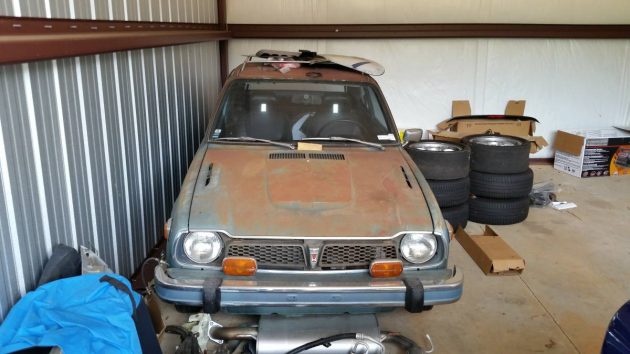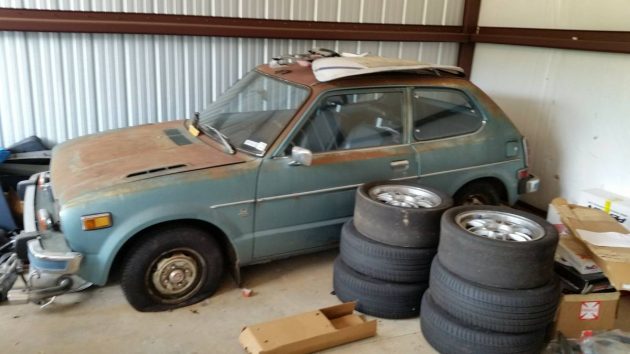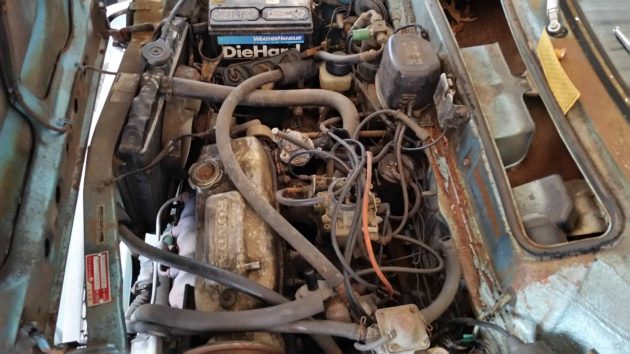Nobody in the history of Hollywood abused a Honda more than Bubba Smith in the movie Police Academy. Smith, playing a former florist turned police cadet, finds himself in a predicament where he has to pass his driving test the next day. The only problem was that he had never driven a car before! Enlisting the help of the mischievous Mahoney, they steal a rival cadet’s Honda Civic for a little practice. Smith, who is six-foot seven-inches tall, yanks out the front seat of the hapless Civic, and proceeds to terrorize the town once he gains his confidence. While I am sure this is not the exact Civic from the movie, this 1977 Honda Civic, found on Craigslist in Taylor, Alabama, looks pretty much like the car when Smith finished with it and abandoned it in the academy parking lot. Listed for $1500, this Civic may be a bit overpriced for the condition, but when was the last time you saw one?
After a little research, I think I can tell you why they are so rare. First generation Hondas were subject to massive recalls over rust, especially in areas where the roads were salted in the winter. Honda had to offer customers a repair or replace option for front fenders that rusted in three years or less from when they were sold. Worse yet, another recall demanded that Honda repair the suspensions on thousands of cars because rust made the cars unsafe to drive. Cars that were rusted beyond repair were bought back from customers. While the cars themselves were reliable, this really hurt the company’s image when they were trying to establish themselves in the American market.
That was a shame, because the Civic was really a breath of fresh air in comparison to its main competitors, the Ford Pinto and the Chevrolet Vega. The cars were light, easy to drive, cheap to maintain, and got fantastic fuel mileage. Given the problems the Pinto and the Vega had in regards to design issues, maybe the rusting recalls didn’t hurt Honda’s reputation all that badly. At any rate, Honda’s formula of light weight and front wheel drive ended up being the right one for the marketplace. While the first generation Civic could be considered a sales success for the company, the second generation was the one that really put Honda on the map in the United States.
This particular Civic has seen better days. Equipped with a 1.2 liter inline four cylinder engine, and a two speed HondaMatic transmission, I doubt this car will be running on the Bonneville Salt Flats next year. In fact, it has a problem running around the block. The owner thinks that the engine might be frozen up. While the repair won’t likely be cheap, there is no shortage of Honda engine experts in the United States. A few might even suggest some horsepower upgrades, which would go a long way towards making the car more at home in modern traffic. Another good aspect of working on Hondas is that Honda often keeps parts in stock for a long period of time. While every part you need is probably a click away somewhere on the internet, it is always nice to be able to order from the manufacturer. Pricey, but nice.
Once you get the engine repaired and line up your parts, this could be a fun restoration. There is not much there as far as the size of the vehicle, and you’d probably find that a lot of the parts would need cosmetics only. Regardless of the rust issue, Hondas were known for their quality and longevity. While the asking price seems a tad steep for what you are getting, this car would be a hit with everyone once you fixed it up. A lot of people found themselves behind the wheel of Civics, and you’d end up like Elvis trying to leave the building with adoring fans talking your ear off at the cruise in. Its not a classic, but it is a cool conversation starter.
Extra points if you rip out the front seat and drive from the back seat like Hightower.




I had one in 1980…a ’76 CVCC. I think it was a ’76. Orange with a big fat back stripe down the center. Like a slot car. This one is kind of beat but it would be fun to find another.
always good to see a motor running no air filter…someone took great care of this one!
Saw one last weekend in about this condition. They were starting bidding at $250 at an estate sale. Too rusty for me and it wasn’t getting much attention. California car.
I so love that you made the Police Academy reference as that is all I can think of when I see these too.
Had one same colour, 4 speed loved it!
Id like to find another id put a later model vtech in it.
Not sure if this is a CVCC but nonetheless:
My buddy’s girlfriend had a CVCC and it never ran right. I soon discovered that what I thought had something to do with the model like SE, LE, etc, CVCC actually stood for , as I recall, Compound Vortex Controlled Combustion.
While the weird stuff didn’t bother me then and it still doesn’t, I said ‘uh….no’
It couldn’t have been that complicated in the mid/late seventies but it sure sounded complicated. As I recall, it was akin to a two barrel carburetor with one of them being really, really small. That small “barrel” would run relatively rich and help with the combustion of the other that was set-up lean. But that is the guess that has stuck in my head for darn near forty years. I may have it all wrong though – again :)
Tom, I watched Ed China on Wheeler Dealers give a long, simplified explanation last night. Basically what you said- the smaller throat in the carb supplies rich mixture of fuel to an extra inlet and extra valve, which serves to ignite the much leaner main mixture. Brilliant engineering at the time.
I can’t help but remember that the head of Chevrolet said something to the effect of the CVCC system being ok for a toy motorcycle engine but it wouldn’t work on an American V8. So Honda bought an Impala, modified it for CVCC and passed emissions without a cat or a smog pump. Love it.
You pretty much nailed it tom
The rich mix got ignited in a tiny chamber and that bigger fire ignited a lean mix.
They were ao clean they didnt need a cat.
Mine was a normal 1200 and even back then the cvcc had a reputation as being troublesome
I dated a girl in high school (early ’80s) who had one of these. Hers was brown, so if it was rusty she probably didn’t see it. A lot of great memories of the girl, but very few of the car other than it was tiny inside and out. For reference, I was driving a Fox Capri at the time and it seemed huge in comparison.
Oh yeah, my wife had a ’79 Accord (also brown!!) with Hondamatic transmission. There is no more vile transmission on the planet if you ask me.
It could be a fun project, but the price of admission seems awfully high to me…
Honda even did a Hondamatic motorcycle back in the 70’s, so wrong.
At any rate, Honda’s formula of light weight and front wheel drive ended up being the right one for the marketplace.
-Learned from the Mini……..
We smack talk automatics all the time but the hondamatic was truly a pathetic POS
These were great little car, I had three of them in succession each being a parts car for the next. They ran well were reliable and great on gas but yes rust was there week point, the thing that I’d watch for was how much rust was in the front strut towers. My last one was the best of the bunch I traded out the broken engine for one of my spares and daily drove it for 5 years great little winter car with front studded tires you could go threw anything.
Its raining CVCC’s!
https://sfbay.craigslist.org/sfc/cto/d/1981-honda-civic-wagon-5spd/6272757530.html
Friends’ dad bought one used in the early or mid eighties for the older boys to run around in through high school years in rural Penna. bright yellow and rust. We all called it the “Corker” because the previous owner had substituted a big cork for a missing oil fill cap. Not sure what brought it down. Rust? Tree? No, a tree took the Skylark!
Still driving my 1978 Honda Accord with the CVCC engine. Never failed a California smog test in 39 years and never been out of service. Five speed a delight. 25+MPG . Nothing but fun.